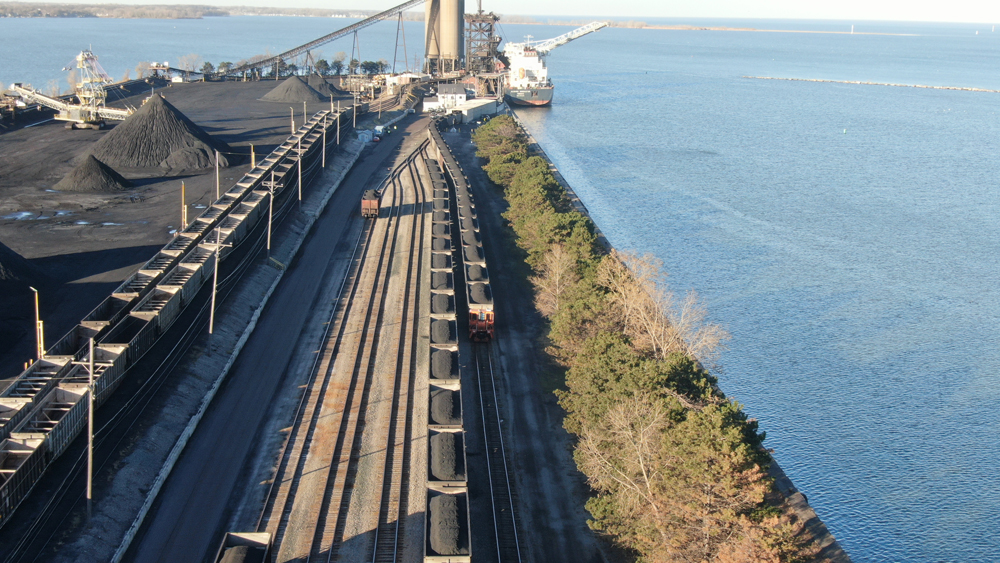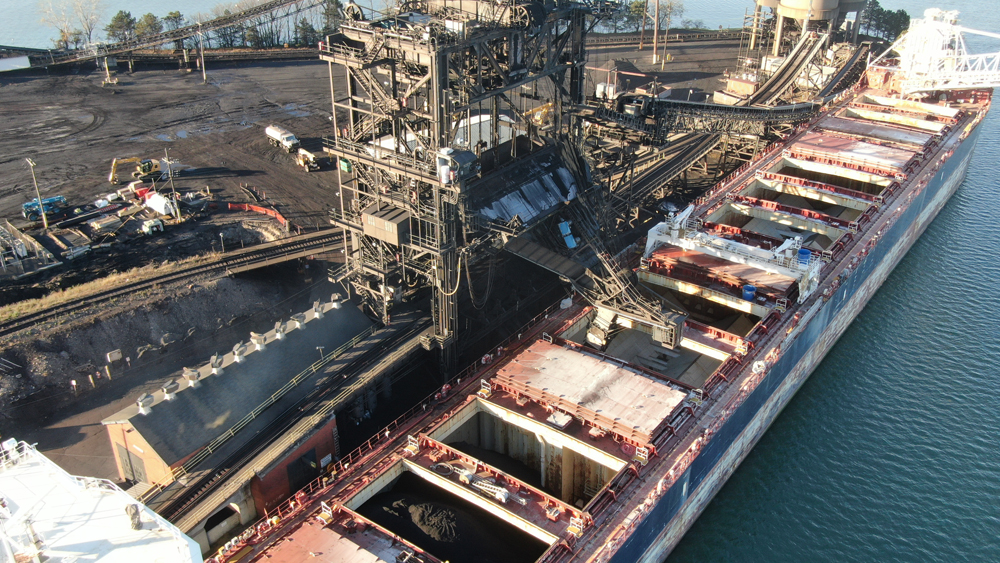Sandusky coal dock

The early days
Sandusky, Ohio, is the roller coaster capital of the United States. It is home to the Cedar Point amusement park, which has sixteen of the fastest, wildest, most thrilling coasters anyone has ever seen. But did you know there’s one more? You can’t ride on it, and many Sanduskians have no idea it exists, but Norfolk Southern’s Sandusky coal dock has been there longer than any other ride in the city.
Sandusky has been a coal port since 1891. The Sandusky & Columbus Short Line Railroad built a line to the lakeshore, linking coal mines in the Hocking Hills region of the state with Great Lakes shipping lines. Cars were unloaded by hand before a crane-based system known as the “Whirly” was introduced in 1893. It unloaded individual coal hoppers into a series of buckets that were craned over a ship’s hold and dumped in. Five years later, in 1898, the “Whirly” was replaced with a steam-driven lift that emptied entire coal cars into the waiting holds of lake freighters. Capable of 16 cars per hour, this slow process was a vast improvement over the previous method of loading.
As demand grew intensely, and less than a decade later, the S&CSL — now the Columbus, Sandusky, & Hocking — was purchased by the Pennsylvania Railroad. The line leading from Columbus to Sandusky became the Sandusky District, terminating at the coal dock, which also came under Pennsylvania control.
The PRR immediately began improving its new acquisition, upgrading the 1898 system with a 25-car-per-hour loader in 1902, and building a second coal dock (now known as Pier 2) to supplement the first (Pier 1). A second coal dumper was installed on Pier 2 in 1914, and by the 1930s, the two docks were working round the clock to load waiting lake freighters.
Taking things to the next level
In 1937, with Piers 1 and 2 operating at full capacity, the Pennsylvania began an absolutely gargantuan expansion project. Piers 1 and 2 are both roughly 900 feet long, about 150 feet wide, and capable of moving 20 to 25 50-ton railcars per hour.
The new Pier 3, on the other hand, was 5,000 feet long and 600 feet wide. Eleven million tons of sheet steel and pilings were used in its construction, as was 2.5 million cubic yards of silt, dredged from the bottom of Sandusky harbor. The extensive dredging created a new channel in the harbor, allowing ships of almost any draft to enter Sandusky’s port. The loader itself stands 175 feet tall and can handle 30 to 35 50-ton freight cars per hour.
With the massively expanded facility, the docks became a driving force in the local coal trade, and at the height of World War II’s frenzy for raw materials, the three piers shipped 14.3 million tons of coal in 1944, a record that stands to this day.
The loader

One would be remiss, when talking about the Sandusky coal docks, to not take a moment and describe the coal loader itself.
The loader looks like a mid-sized building from a distance, and to the untrained eye, the Heyl & Patterson high-lift dumper gives little clue as to how it operates, until it begins to move. A railcar on the intake track is pushed up a ramp, at the top of which is a platform. Once centered on the platform, the entire device lifts well above the deck of the waiting ship, not unlike a gigantic elevator. The car is drenched with water to control dust, with giant metal bars locking it into place as it reaches the top. The platform then flips, dumping the car’s load into a chute that feeds into the waiting hold of a freighter below.
The empty car is then brought back to dock level, some 150 feet below. Once flipped upright, and back at the top of the ramp, it is pushed off the platform and down the other side by the next railcar, which has just arrived at the top in a feat of carefully planned timing.
The process is still not done. Once the car leaves the lift platform, it rolls down a track which more resembles an unfinished roller coaster from nearby Cedar Point than any piece of railway infrastructure.
The empty freight car rolls down track that abruptly slopes back up into the air, a single bumper stop seemingly all that prevents the car from arcing into the waters of Lake Erie. However, gravity intervenes, and the car rolls backwards down the track and over a spring-loaded switch. This sends the car to ground level, through a set of hump-yard style switches, and into the outbound tracks, ready to be hauled back to Sandusky Yard.
Into the future
As the 1940s turned into the 1950s, it became clear Pier 3 was not only supporting, but in fact supplanting, Piers 1 and 2. Lake freighters were getting longer and wider, and the two old docks could not support such vessels. In 1957, Pier 2 closed, and while Pier 1 continued to serve smaller ships for some time afterwards, it was shuttered in 1969.
Meanwhile, change was occurring in the railroad world. In 1964, as the Pennsylvania Railroad neared the bottom of its economic death spiral that would culminate in the formation of Penn Central, the Norfolk & Western Railroad engaged in a series of complicated mergers, buying or leasing several regional carriers including the Wabash, Nickel Plate, and Pittsburgh & West Virginia. These railways did not have direct connections, so the N&W purchased the PRR Sandusky District, including the coal docks in Sandusky. As had been the case with the PRR, the N&W immediately began making improvements, including the construction of a coal stockpiling facility on the dock. This featured three 194-foot-tall silos, a 2.5 mile conveyor belt system, and an open-air storage lot capable of holding over 1 million tons of coal.
Current operations
The coal dock has changed little in the modern era, operating much as it has since the 1960s. The Norfolk & Western has since become Norfolk Southern, and current coal hoppers have almost doubled in capacity, but this has not affected the massive physical plant in any meaningful way.
Perhaps the greatest change is where the coal comes from. The docks were built to export coal extracted from the rolling hills of central and southern Ohio, but current coal loads come mostly from West Virginia and Pennsylvania. The most common of these is NS train 573, which makes multiple runs per week from Shire Oaks, Pa., to Sandusky during the April-December Great Lakes shipping season.
Most of this coal is for metallurgical purposes, sent to steel mills throughout the Great Lakes region. This has relatively future-proofed the dock’s operations; while coal-fired power plants are being shuttered for environmental reasons, coal is still required to manufacture steel. Thus, it is likely the docks will continue to operate long into the future.














Nice write-up but the author has not been paying any attention to the steel business lately. Blast furnaces in this country, mostly located around the Great Lakes, have been dropping like flies–as fast or even faster than steam coal-fired power plants. The US is down to 13-15 operating BFs depending on market conditions, and several don’t take coal through the Sandusky dock. Some industry observers think they may disappear completely by 2040 or 2050, if not sooner. The shipping of met coal, and the Sandusky coal pier, is thus not in any was guaranteed to last well into the future as is mentioned here. And it doesn’t take much legwork to find this out, bad newboy journalism in my book…
Injuns